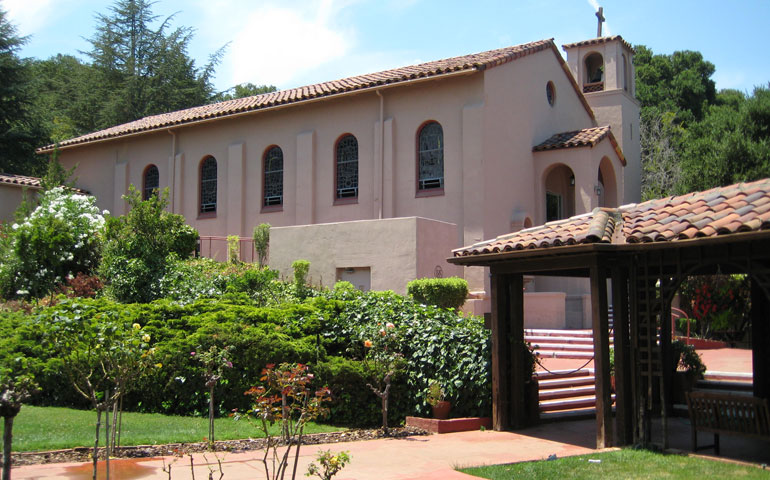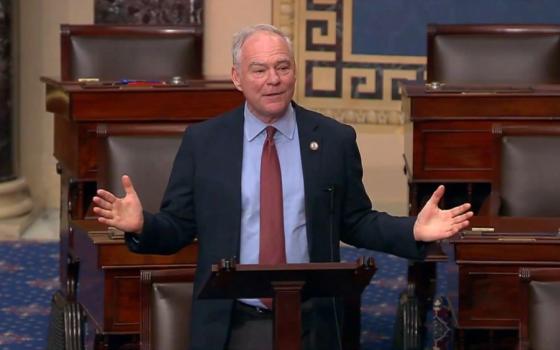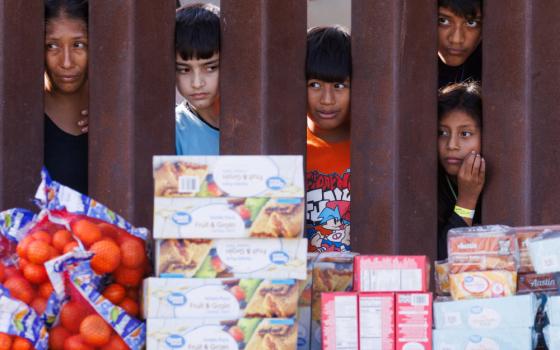
The Rossi Chapel at the Jesuit Retreat Center of Los Altos, Calif. (Photos by Br. Thomas Koller, SJ)
We’ve completed undergraduate degrees at prestigious universities. We’ve served in communities around the world as members of the armed forces, the Jesuit Volunteer Corps and Teach for America. We aren’t sure if our jobs will turn into lifelong careers. We’re living at home with our parents after completing our master’s degrees or before venturing out for our next step. We’re in the first few years of marriage, hoping to bring a child into our family or becoming parents for the first time. We don’t know why the priest wears a purple stole this week, but a red stole next week. We don’t know exactly when during the celebration of the liturgy the bread and wine become the Eucharist. We haven’t memorized the exact order of the Mass or committed the rosary to memory. We don’t know the feast days ... until we Google them. We are not theologians, church historians, members of religious orders, ordained priests or women religious; we wouldn’t even describe ourselves as devout Catholics.
And yet, 30 of us turned our cell phones off, left our laptops at home and our Gmail accounts unread, and gathered at the Jesuit Retreat Center of Los Altos, Calif., to “Unplug and Connect.”
This past January, somewhat overwhelmed by the change that the new year often brings, I joined 29 other young adults for a three-day spiritual retreat. Rooted in Ignatian spirituality, contemplative prayer and the sacraments, the retreat had many components. At sunrise each morning, some of us prayed the Our Father as we stretched our bodies in a series of sun salutation yoga positions. Others woke and walked together in silence through the retreat center’s gardens for a walking meditation. Still others joined in the chapel to participate in the age-old practice of lectio divina.
Throughout each day, we heard personal stories from our young adult leaders about facing failure and finding faith. We shared silent spaces during centering prayer and reflection. In small groups, we shared our experiences and talked about what it means for us to live faith as a young adult. One evening we viewed “Happy” -- a documentary of life stories that shared contemporary research on happiness.
The night before we left, we celebrated a “teaching liturgy.” It was the most profound and intimate experience of Catholic liturgy that I have ever celebrated. For the first time in my young adult life, though I sat in a pew toward the back, I felt cherished, respected and esteemed: I felt a sincere connection with the source and summit of the Catholic faith.
After the gathering rite, our Jesuit presider shared a few thought-provoking facts about the altar, altar table and chapel space. Then he encouraged all of us to ask questions and to share what we knew about the liturgy as our celebration unfolded. As the liturgy continued, he offered us many trustworthy insights. He shared what he knew honestly and humbly -- adding a garnish of humor in those moments that were beyond answers. He shared the significance of the different liturgical colors, explained the purpose of each genuflection, and drew attention to the meaning of our prayers and songs. As we shared this sacred meal, our questions were received, not as interruptions, but as invitations. This sacred gathering opened up a space for all of us to share our questions, to announce our anxieties and to admit to our unknowing. In this liturgy, we confirmed our limitedness out loud and we questioned into our faith together.
While the significance of the liturgical colors, or the theologically appropriate name for the liturgical vessels used during the meal now escapes my memory, the spirit of companionship-in-questioning that filled the chapel throughout the liturgy continues to move me. We prepared the way for the mystery of our faith to unfold. Hearing each other’s storied questions allowed us to recognize that, especially in the celebration of liturgy, we ask our questions together. As hearers of the word, as members of a pilgrim church, we gather to celebrate our journey as a community of faith that questions toward meaning.
This experience of liturgy encouraged me to reflect on my image of the church. What is the church? Who is the church? What comes to mind when I think of church?
Many young Catholics construct an image of church based on our experience of a Sunday morning ritual. Church consists of a priest and altar servers who don outdated attire, carry tall candles, swing smelly incense, and perhaps ring high-pitched bells during an hourlong liturgy full of confusing rituals. Until about eighth grade, a religious education class or the distraction of donuts often accompanies Sunday morning liturgy. With the exception of the few people who attend Catholic high school, many do not continue formal religious education during public high school. During their years in college, some young Catholics find a home in campus ministry, while others participate in liturgy only on occasion.
In the years after undergraduate, whether we admit it or not, young adults live in mystery every day. We live in the realm of unanswered questions, unpredictable futures and unarticulated desires. At times, the magnitude of uncertainty stifles and suffocates us. We spend many of our days reaching out to attain the next goal, and many of our nights wondering what it is all for. We live in a hypertechnological age of constant motion, continuous communication and perpetual transition. We have instant and individualized handheld access to technology that allows us to move beyond traditional boundaries. We can connect with others across time zones, over oceans and on multiple continents.
Yet, we reach across the aisle at our local parish and we cannot find the hand of another young adult. We attend our local Catholic parishes, but we do not find a strong community of young adults. We want to share in sacred conversation. We want to participate in the life of the church and the process of tradition: We want to lead lives that receive, animate and pass on the rich complexities of our faith. We want to be trusted with the word.
This young adult retreat opened my eyes to a new image of church. In this new image, 30 young adults share familiar struggles, expectations, hopes and fears. They gather with unique stories and intimate questions. In this image, the particular uncertainties of 30 young adult lives bring the church to life. In this church, all are celebrated in sacred meal.
On this retreat, I experienced a church healed from its self-referential sickness. I celebrated with a church that, at the risk of stumbling and falling short, stepped out into the storied streets of young adult life and listened. In this retreat, especially in this teaching liturgy, I connected to a church that celebrates the goodness of our questions. I participated in a church courageous enough to journey off its island of certainty and into the mystery alive in its pews.
[Loretta E. Johnson is from Washington, D.C., New Orleans and Oakland, Calif.]


